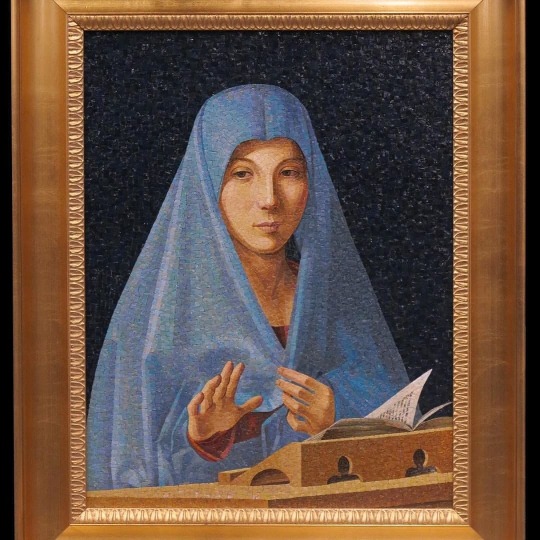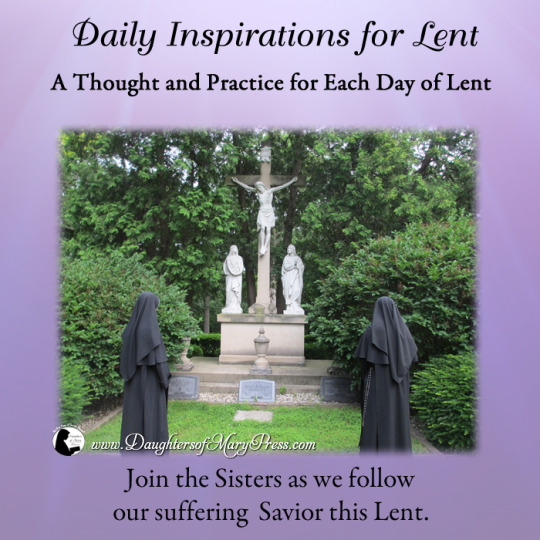#blessedmother
Text

Our Lady of Lourdes
Feast Day: February 11
Patron saint of bodily ills
On February 11th, 1858 Our Lady appeared to St. Bernadette in the cave of Massabielle, Lourdes, France. This began a series of apparitions. During the vision on the 25th of March she told Bernadette, “I am the Immaculate Conception.” Lourdes is one of the most frequented Marian Shrines in the world. It is known as a place of healing, with over 60 miraculous cures that have been recognized by church authorities.
Prints, plaques & holy cards available for purchase here: (website)
103 notes
·
View notes
Text

#virginmary#religiousjewelry#madonnapendant#mothermarypendant#religiousmedal#14kgold#realgold#blessedmother#blessedmarymedal#virginmarymedal#vintagejewelry#genuinegold#14K#YearsAfter#Etsyseller#Etsysuccess
11 notes
·
View notes
Link
In this episode of The Heart of Fiat Crucified Love, Catholic missionary and evangelist Mary Kloska speaks about the last chapter of her book 'House of Gold' that presents Our Lady as the Queen of All Hearts and the Queen of Peace. She not only explains the history of Our Lady's title as our Queen Mother, but she provides the listener with a reflection as to what that means in the life of every Christian. After having concluded this preparation for Marian Consecration, Mary provides a prayer of Consecration to Our Lady's Immaculate and Sorrowful Infant Heart. (March 24, 2024)
#blessedmother#marykloska#ourlady#queenofheaven#queenofpeace#theheartoffiatcrucifiedlove#virginmother
0 notes
Text

#Join the Sisters this May as we offer our hearts to Mary with these daily practices.#DaughtersofMaryPress#DaughtersofMary#ReligiousSisters#BlessedVirginMary#MaryMotherofGod#BlessedMother#OurLady#MonthofMary#StJohnBosco
0 notes
Photo

Happy 3rd Month My Little Snow White ❤️ We love you so much our Elia Laurice 🥰 #09262022 #BlessedMother❣️ (at Maragusan, Davao De Oro, Philippines) https://www.instagram.com/p/CjAZB-CBi94L1vvS2Vrt6c_hysGAK377-7ZIzA0/?igshid=NGJjMDIxMWI=
0 notes
Text
4 notes
·
View notes
Photo

This photo has been infused with the Energy of Lourdes, France. It is place of many miracles. Here is the link to the Energy of Our Lady of Lourdes, France, video, http://bit.ly/3QMjHdR For the January Reiki Sunday Special (to make life easier) go to ReikifromLourdes.com #restrelaxationreiki #reikifromLourdes #reikienergy #reikihealing #mothermary #blessedmother #OurLadyofLourdes #miracles
0 notes
Text

Amen to the apples that fell
so that we could fall to the Earth
and feel our bodies
Belly to dirt.
Amen to the enticingly round globe of red, color of blood, seductive juicy wisdom
Amen to wanting just one bite.
Amen to woman, blessed woman
Round and voluptuous in her skin,
Redefining sin, redefining pleasure
redefining becoming
redefining sensual
redefining the gift of shedding and snakes.
Amen to the uterus
The universe
Butterfly of creation
Always transforming
Life Death life
There is a reason the apple seeds
Together form the shape of a star
And that apple is round
like a woman's plump belly
When she is full of creation
Whether blood or babe
Art or story
Ancestral memory or destiny songline
Motherland stories
A wild Matryoshka
Universe blossoming like flowers
Offering fruit
The wisdom of life experience.
Once Upon a Time
God was a woman.
Words: the wild matryoshka
Image: Liz Darling
Source: https://www.facebook.com/thewildremembering/photos/a.2959906867451970/4743316239111015/?type=3
#blessedmother🍎🌸🍷🪷🌟🍯🈴♾️ ☀️🌕🐚🪺🌱🦋#mothersdayweekend2022
1 note
·
View note
Photo

Reposted from @fathermcgivney Today we celebrate the feast of the Nativity of the Blessed Virgin Mary with this Vatican Mosaic Studio depiction based on Antonello de Messina’s painting. Our Lady’s chaste gaze expresses her grace. It seems to radiate towards the viewer, and emanates today’s Antiphon: “Your birth, O Virgin Mother of God, proclaims joy to the whole world, for from you arose the glorious Sun of Justice, Christ our God.” #FeastDay #Feast #BlessedMother #VirginMary #MaryMotherofGod #BlessedVirginMary #VisitFromHome (at United States) https://www.instagram.com/p/CTkECZQrNx7/?utm_medium=tumblr
2 notes
·
View notes
Text


Our Lady of Pontmain (Our Lady of Hope)
1871
Feast Day: January 17
Patronage: Pontmain, France and Hope
In 1871, France was being devastated by the Franco-Prussian war. The Prussians were close to the town of Laval when on the evening of January 17, Eugene Barbedette and his brother Joseph saw an apparition of our Lady. A crowd gathered but only children could see the apparition, not adults. After the town gathered praying and singing, she told them that “God heard their prayers and fears and would answer their needs.” That same day, the Prussians halted their advances when their commander encountered an “invisible Madonna barring the way.” In May that same year, a peace treaty was signed. The local Bishop approved the apparition in 1872 and in 1908 the church was dedicated as a Basilica to Our Lady of Hope of Pontmain.
Prints, plaques & holy cards available for purchase here: (website)
64 notes
·
View notes
Photo

NEW REVIEW & DEMO: @godsmomdotcom The Blessed Mother: Fuzz Assumption A knob tweak makes this classic original tone-shaper into a killer fuzz/overdrive....Check out our website and YouTube channel for all the info! . . . . . #pedaloftheday #guitarpedals #guitareffects #effectspedals #pedalsandeffects #gearnerds #gearpassion #becausetone #knowyourtone #tonefordays #toneheaven #gearshots #gearphoria #notpedalbored #heatherbrown #blessedmother #fuzzassumption #fuzzpedal https://www.instagram.com/p/CSt8Wwor77H/?utm_medium=tumblr
#pedaloftheday#guitarpedals#guitareffects#effectspedals#pedalsandeffects#gearnerds#gearpassion#becausetone#knowyourtone#tonefordays#toneheaven#gearshots#gearphoria#notpedalbored#heatherbrown#blessedmother#fuzzassumption#fuzzpedal
1 note
·
View note
Link
In this episode of The Heart of Fiat Crucified Love, Catholic missionary and evangelist Mary Kloska continues to guide her listener through her Marian Consecration Book 'House of Gold.' Here she presents Chapter 6: "Who Is Our Sorrowful Co-Redemptrix?" Speaking about the Sorrowful Heart of Our Lady and the gift of Her Tears, she encourages the listener to confide all of their own sufferings, petitions and entire lives to the care of Our Sorrowful Mother.
#blessedmother#coredemptrix#houseofgold#marykloska#maryofcalvary#sorrowfulheartofmary#sorrowfulmother#tearsofmary#theheartoffiatcrucifiedlove#towerofivory
0 notes
Photo

Self-Portrait. Jersey City. December 2020.
#religious art#religious statues#blessedmother#fujifilmxpro3#xf56mmf1.2#jerseycity#newjersey#stigmata#angels#Religious iconography#streetphotography#luxlit#imiging
7 notes
·
View notes
Text

Join the Sisters this Lent as we follow our suffering Savior this Lent.
#DaughtersofMaryPress #DaughtersofMary #ReligiousSisters #JesusMaryJoseph #Lent #LentenSeason #LentenFast #CatholicPrayers #TraditionalCatholic #CatholicChurch #HolyMass #BlessedMother #FeastDay #AllforTheeJesus #shortprayers #CatholicBlessing #MyCatholicFaith #Mortification
0 notes
Video
https://www.shutterstock.com/tr/g/Feryalsurel. #blessed #blessedwithcurls #blessedlife #blessedmother #blessedtohaveyou #feelingblessed #blessedlove #blessedbeyondbelief #blessedlife🙏 #blessed❤ #blessed🙏 #blessedbeyondmeasure #blessedisshe #blessedandhighlyfavored #blessedup #blessedmama #blessed😇 #blessedbygod #blessedandgrateful #blessedhands #blessedday #blessedsunday #feelblessed #blessedwiththebest #blessedmom #stayblessed #blessed🙌 https://www.instagram.com/p/CIEU3HOpjCL/?igshid=nd2vedfay74w
#blessed#blessedwithcurls#blessedlife#blessedmother#blessedtohaveyou#feelingblessed#blessedlove#blessedbeyondbelief#blessedlife🙏#blessed❤#blessed🙏#blessedbeyondmeasure#blessedisshe#blessedandhighlyfavored#blessedup#blessedmama#blessed😇#blessedbygod#blessedandgrateful#blessedhands#blessedday#blessedsunday#feelblessed#blessedwiththebest#blessedmom#stayblessed#blessed🙌
3 notes
·
View notes
Text
Misappropriated Language and Outmoded Ideology in the Church, and How We Might Move Beyond Them
A good friend and fellow priest posted this past Sunday on his Facebook page that he had been frustrated in trying to write a sermon, feeling that so much of the language he would normally use had been coopted and tainted by right-wing Evangelical white nationalists. The following was my reply to him (with a few minor points of clarification added here):
‘Fr. Karl Rahner once said that he thought the Church should fast from using the word “God” for at least fifty years, until we can all get clear about what we’re actually doing and saying with a term like that, and get deeply rooted and serious enough in our theological speculations to warrant its use. (Fr. Richard Rohr suggested we take the same approach with the name “Jesus”, and I concur; in fact, I think we are much more in need of fasting from this latter name than from the former.) It seems to me that there’s a great deal of wisdom in this approach. What you point out here is the principal reason why the “Jesus Movement” language so ubiquitous in the Episcopal Church today feels misplaced to me, and in fact really chafes every time I hear it. Don’t get me wrong, I love the Presiding Bishop and the basic elements of his vision, but I find this sort of language to be hitting the wrong chord. To me it feels ill matched with where the Church is at now, and where it should be going—and with where the world is at with regard to the Church. It partakes of precisely the same sorts of dissonances you’re highlighting. In the Western Church today we are always in danger of simply repeating platitudes, or unwittingly furthering falsities by allowing ourselves to remain stuck with misappropriated and imprecise language. Most peoples’ “Christology” in the West (if you can even call it that—maybe we should say “Jesusology” instead) is, in my humble opinion, really lacking the deep roots of the tradition. And that leaves us with a rather small and limited vision. This is one reason (among several) why I almost exclusively use “Christ” in religious discourse, or “Christ-Sophia”. I think we need that sort of lens again, which is both broader and more nuanced, and which, if we’re intelligent about it (rather than merely reactionary or political) can liberate us from all the heinous misunderstanding and misuse that has colored Christianity in the West for so long, and afford us a much more effectual set of linguistic and imagistic tools for legitimate transformation. Rahner also said, “Christians of the future will be mystics or they won’t exist at all.” In my view, that’s where we’re headed now from this particular crossroads, if we have the depth and courage to claim the calling of real religiosity. As I perceive it, that’s the divine invitation. And it can most definitely take us into a truer, more authentic, and more rooted place, away from all the baggage of the language and imagery you’re rightly lamenting.’
I saw a photo today from the Capitol riot on January 6th. In the background of the photo was one of what appears to have been many ‘Jesus Saves’ or similar signs present at that event. No doubt those folks also consider themselves to be part of the (‘true’) ‘Jesus Movement’. To be sure, their coopting of Jesus as a figure who supports their insane fundamentalism, egoic delusions, and desire for power is corrupt and evil, but I wonder how ours really differs, structurally speaking. The (white) progressive Jesus is ‘nicer’, but is our understanding of what such a figure really means and invites us into that much deeper than their reactionary, fundamentalist version of the same? Both expressions are drawn in essence from the same literal-historical trends in hermeneutics; it’s just that they emphasize different elements of received texts and interpretations. Granted, I strongly affirm that the emphases of right-wing Evangelicalism (and Evangelicalism at large, in fact) are objectively destructive and immoral, but fundamentally both interpretations play the same sorts of hermeneutical games: they operate in the same playing field, not only culturally (in a homogeneous container), but also religiously.
In other words, all Christians in the West are at some level responsible for this cancerous appropriation of Christian values. Even in progressive circles, in spite of our best intentions, we partake of the language, the dominator cultural styles and structures that have birthed and perpetuated all this toxicity. Until we face that head-on, how can we go about the real work of healing or ‘wholing’ ourselves into a mode of religiosity that is finally supportive of the values of Life, of Nature, of Divinity, rather than blatantly contrary to them?
One of the many problems we face now as people in the Church who want desperately to lead it in a direction of Life—rather than death, ignominy, political coopting, immorality, and corrosion—is that most Western Christians have a rather surface-level view of Jesus, and of Christ more broadly. So the toolkit we’ve been given to work with to articulate a better vision for ourselves is extremely limited. In the United States particularly, it should now be abundantly clear how tied up with right-wing nationalism, racism, and dominator values this theologically underdeveloped mode of Christian language has become. This means—obviously, I hope—that we need to expand and deepen our toolkit, drawing from the deepest and most life giving roots of the tradition.
The lack of adequate Christological understanding is not the fault of ordinary Christian folk; it’s what has been fed to them by their clergy, and it’s what was taught to most of those clergy in seminary for the last two or three generations. It’s what I call the ‘social Gospel, historical Jesus’ trend, and, in my view, this is a trend that has utterly crippled mainline and progressive Christian denominations, and in many cases created a notion of Christian religiosity as (essentially) little more than social justice work with a veneer of religious language. Of course, the work of justice is crucial, but what happens when we scrub away the Mystery, the experiential, inward transformation that is actually required to give rise to authentic justice, the richness of myth and symbology, leaving only this ‘social Gospel, historical Jesus’ layer of ideation? Well, as I’ve been saying for many years now: I think it is perfectly plain to see what happens in that case, as we now see it playing out all around us: the Church is collapsing, and (ironically) has almost no socio-cultural clout, which is the only thing it seems to have really desired for the last five or six decades.
I pray that people will finally be ready to move beyond all this, into something with real transformative capacity. But, alas, I suspect many, if not most, will not. So many Western Christians, of whatever stripe, seem absolutely determined to cling to all manner of outmoded and unhealthful aspects of Christian religious expression, language, and dogma, simply for the sake of safety, comfort, and security in the ‘known quantity’. And that, we can be sure, will lead us nowhere, both individually and collectively.
Might we not attempt to root our religion in actual religion? In other words, can we not learn once more to base our religious affiliation and practice on a legitimate and appropriately comparative understanding of myth, religious narrative, the ‘perennial philosophy’, and the actual aims of religiosity—namely, the science of spiritual transformation through initiatory, ascetical, liturgical, sacramental, and other modes of productive individual and communal sacred work? Haven’t we had enough of basing our religion on socio-cultural and academic trends in lieu of what actually transforms? Are the disastrous results of that finally clear enough for all to see? Of course, we must evolve with the times—I am by no stretch of the imagination a reactionary, and I am stringently anti-fundamentalist in every possible way—but this current disaster we now inhabit is what happens when, in the rush and distraction of that process of cultural evolution, we lose touch with the real root and purpose of the whole operation in the first place; that is, when we lose our memory and understanding of what religion is actually for and what it’s meant to accomplish in the human person.
I won’t enter here into the many additional issues related to male dominator language and the rest of the attendant cancerous threads that have long plagued Abrahamic religious expression, or their effects on Church and society; if you’re interested in all that, you might find some food for reflection in my book, Seeds from the Wild Verge. But here’s an idea: Let’s focus on the Blessed Mother for a while—very deeply: not just linguistically and imagistically, but theologically and practically as well, in a nuanced and committed fashion, not for purposes of political correctness but out of profound theological curiosity and a spirit of expansive internal exploration. God knows all you Protestant types out there could use a serious (and indefinite) dose of the Mother.
I was reflecting recently on what a truly sad circumstance it is that I often feel I can much more readily find depth and theological nuance in contemporary Hindu discourse on Christ, the Blessed Mother, etc., than I can in contemporary Christian discourse on the same. A terrible irony. It often feels to me as if we need to restore Christianity with inspiration from non-Christian sources—something I’ve done in my work with native Celtic traditions, but which could (and perhaps should) be done with inspiration from other arenas as well; for instance, from Vedanta, which has not only unequivocally maintained a far more refined and mature view of religion and its aims than most Christians have, but in fact often seems to possess a more mature view of Christianity than most Christians presently do.
Writing in 1963, Swami Prabhavananda astutely observed: ‘Of course there are millions of Christians today who attend churches regularly…but of those who do, few seek perfection in God. Most people are satisfied with living a more or less ethical life on earth in hope of being rewarded in an afterlife for any good deeds they may have done. Christ’s ideal of perfection is generally either forgotten or misunderstood. True, many people read the Sermon on the Mount, but few try to live its teachings.’
Now, almost sixty years later, that statement proves to be even more radically true than it was then. We have much work to do, friends, if we wish to restore the Church to something that truly transforms, which is truly relevant in a perennial way, and which is positioned not only to survive but to once more contribute something of inestimable value to the world. This will involve us, should we have the courage take up the task, in reclaiming the profound Mystery in Christian tradition, its ancient spiritual practices, and its expansively symbolic depth. May we set out with open hearts on that next adventure—and may we do so quickly.
Peace and every blessing,
Fr. Brendan+
#brendanelliswilliams#nature#earth#mysticism#ancestral#depth#journey#transformation#theosis#wholeness#holistic#reclamation#christianity#catholic#animism#femininedivine#blessedmother#celtic#church#rewilding#soul#spirit#perennialphilosophy#spirituality#spirituallife#religiouslife#awakening#spiritualawakening#priest#monk
4 notes
·
View notes